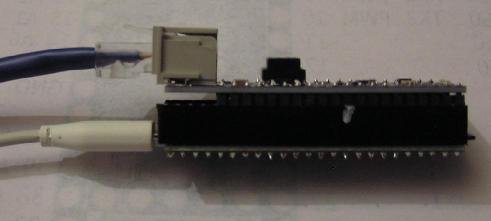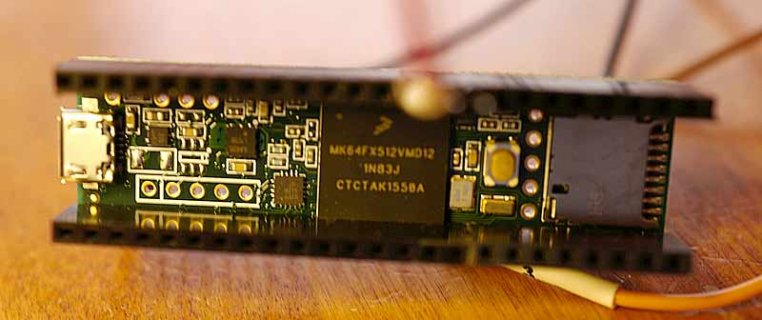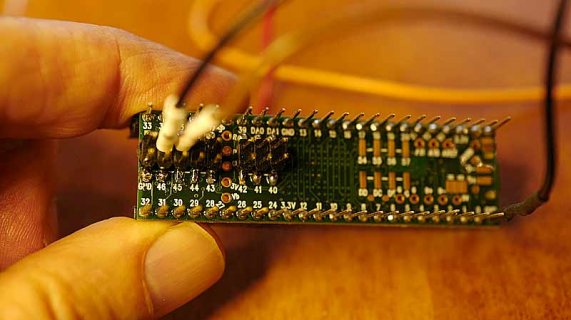defragster
Senior Member+
As seen on Kickstarter: kickstarter _ paulstoffregen _ teensy-35-and-36
A few Beta T_3.5 units arrived in the world 8/31/16 - This thread for related general posts. While the K66 and K64 are greatly similar, starting this new thread as the old one has months of history and while similar, notes here may be K64 specific.
the Teensy 3.5 K64 is __MK64FX512__ [ corresponding ID for Teensy 3.6 K66 board is __MK66FX1M0__ ]
Preliminary Eagle footprint Library For KS Teensy 3.5/3.6, Another Eagle Teensy drawing and Another version Eagle Library - includes prior Teensy 3 and LC
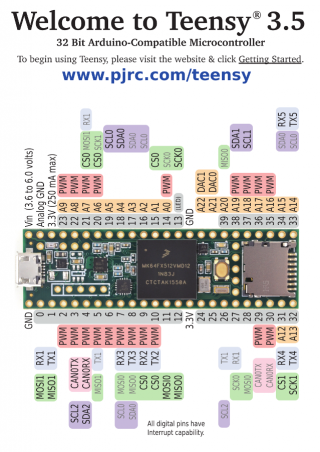
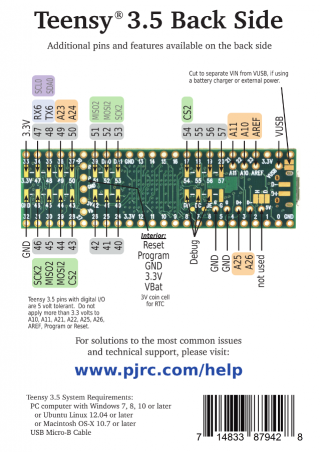

Kickstarter packages will include a card like this with each Teensy NOTE: the inset detail on the backside, the cards shipping with KS Rewards erroneously suggest 5V, above it properly shows 3.3V on the indicated analog pins.
This thread is a parallel partner to the K66 T_3.6 thread located here:: forum.pjrc.com/threads/34808-K66-Beta-Test
The Teensy 3.5 is a 5 volt tolerant [ on digital I/O pins ] part, similar to the Teensy 3.2. Many notes here may apply to the linked K66 thread above - but not all, see below for up front differences.
Datasheets K64 (5V tolerant):
K64 Data Sheet (electrical specs): data_sheet/K64P144M120SF5.pdf
K64 Reference Manual (programming specs: ref_manual/K64P144M120SF5RM.pdf
Teensy 3.5 Features:
•120 MHz ARM Cortex-M4 with Floating Point Unit
•512K Flash, 192K RAM, 4K EEPROM
•Microcontroller Chip MK64FX512VMD12 (PDF link)
•1 CAN Bus Port
•16 General Purpose DMA Channels
•5 Volt Tolerance On All Digital I/O Pins
•62 I/O Pins (42 breadboard friendly)
•25 Analog Inputs to 2 ADCs with 13 bits resolution
•2 Analog Outputs (DACs) with 12 bit resolution
•20 PWM Outputs
•USB Full Speed (12 Mbit/sec) Port
•Ethernet mac, capable of full 100 Mbit/sec speed
•Native (4 bit SDIO) micro SD card port
•I2S Audio Port, 4 Channel Digital Audio Input & Output
•14 Hardware Timers
•Cryptographic Acceleration Unit
•Random Number Generator
•CRC Computation Unit
•6 Serial Ports (2 with FIFO & Fast Baud Rates)
•3 SPI Ports (1 with FIFO)
•3 I2C Ports
•Real Time Clock [Ships with crystal installed]
Major differences T_3.5 w/K64 versus T_3.6 w/K66
T_3.5 :: NO Touch Sensing Inputs
ARM Cortex-M4 w/FPU :: T_3.5 rated at 120 MHz versus T_3.6 180 MHz
RAM :: T_3.5 192K RAM versus T_3.6 256K RAM
FLASH :: T_3.5 512K Flash versus T_3.6 1M Flash
ON T_3.5 ( K64 ) 5V tolerance On All Digital I/O Pins - SEE FINAL DOCS FOR DETAILS!
ON T_3.6 only the VIN pin is designed to get over 3.3V - SEE FINAL DOCS FOR DETAILS!
I2C :: Teensy 3.5 has 3 I2C ports, and four on T_3.6
A few Beta T_3.5 units arrived in the world 8/31/16 - This thread for related general posts. While the K66 and K64 are greatly similar, starting this new thread as the old one has months of history and while similar, notes here may be K64 specific.
the Teensy 3.5 K64 is __MK64FX512__ [ corresponding ID for Teensy 3.6 K66 board is __MK66FX1M0__ ]
Preliminary Eagle footprint Library For KS Teensy 3.5/3.6, Another Eagle Teensy drawing and Another version Eagle Library - includes prior Teensy 3 and LC



Kickstarter packages will include a card like this with each Teensy NOTE: the inset detail on the backside, the cards shipping with KS Rewards erroneously suggest 5V, above it properly shows 3.3V on the indicated analog pins.
This thread is a parallel partner to the K66 T_3.6 thread located here:: forum.pjrc.com/threads/34808-K66-Beta-Test
The Teensy 3.5 is a 5 volt tolerant [ on digital I/O pins ] part, similar to the Teensy 3.2. Many notes here may apply to the linked K66 thread above - but not all, see below for up front differences.
Datasheets K64 (5V tolerant):
K64 Data Sheet (electrical specs): data_sheet/K64P144M120SF5.pdf
K64 Reference Manual (programming specs: ref_manual/K64P144M120SF5RM.pdf
Teensy 3.5 Features:
•120 MHz ARM Cortex-M4 with Floating Point Unit
•512K Flash, 192K RAM, 4K EEPROM
•Microcontroller Chip MK64FX512VMD12 (PDF link)
•1 CAN Bus Port
•16 General Purpose DMA Channels
•5 Volt Tolerance On All Digital I/O Pins
•62 I/O Pins (42 breadboard friendly)
•25 Analog Inputs to 2 ADCs with 13 bits resolution
•2 Analog Outputs (DACs) with 12 bit resolution
•20 PWM Outputs
•USB Full Speed (12 Mbit/sec) Port
•Ethernet mac, capable of full 100 Mbit/sec speed
•Native (4 bit SDIO) micro SD card port
•I2S Audio Port, 4 Channel Digital Audio Input & Output
•14 Hardware Timers
•Cryptographic Acceleration Unit
•Random Number Generator
•CRC Computation Unit
•6 Serial Ports (2 with FIFO & Fast Baud Rates)
•3 SPI Ports (1 with FIFO)
•3 I2C Ports
•Real Time Clock [Ships with crystal installed]
Major differences T_3.5 w/K64 versus T_3.6 w/K66
T_3.5 :: NO Touch Sensing Inputs
ARM Cortex-M4 w/FPU :: T_3.5 rated at 120 MHz versus T_3.6 180 MHz
RAM :: T_3.5 192K RAM versus T_3.6 256K RAM
FLASH :: T_3.5 512K Flash versus T_3.6 1M Flash
ON T_3.5 ( K64 ) 5V tolerance On All Digital I/O Pins - SEE FINAL DOCS FOR DETAILS!
ON T_3.6 only the VIN pin is designed to get over 3.3V - SEE FINAL DOCS FOR DETAILS!
I2C :: Teensy 3.5 has 3 I2C ports, and four on T_3.6
Last edited:


